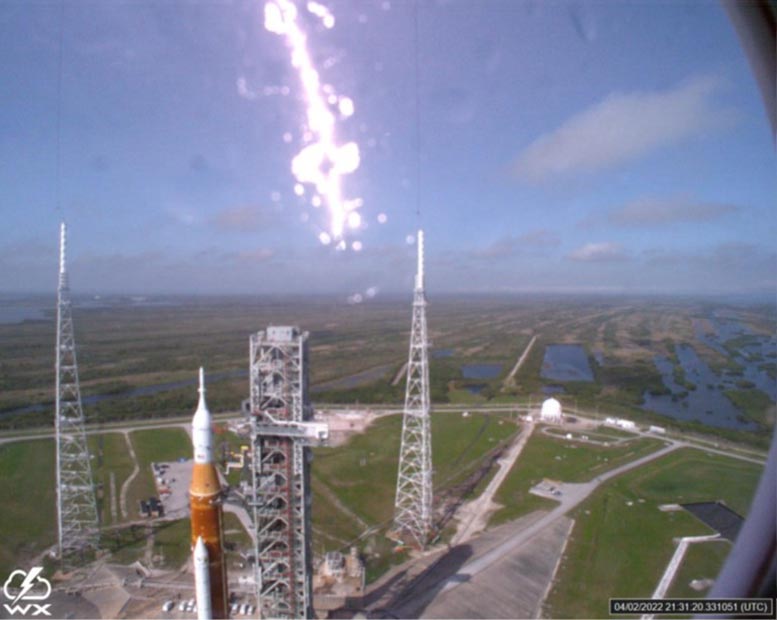
बिजली गिरने की यह छवि 2 अप्रैल, 2022 की शाम को फ्लोरिडा में नासा के कैनेडी स्पेस सेंटर के लॉन्च कॉम्प्लेक्स 39B में ली गई थी। शनिवार, 27 अगस्त की दोपहर को, लॉन्च के समय बिजली संरक्षण प्रणाली के टावरों पर तीन बार बिजली गिर गई। बैट 39B – टॉवर 1 के लिए एक स्ट्राइक और टॉवर 2 के लिए दो स्ट्राइक। क्रेडिट: नासा
SLS) rocket’s core stage and prepared the four RS-25 engines.
Meteorologists with Space Launch Delta 45 predict a 70% chance of favorable weather for launch on Monday, August 29. The weather guidelines for NASA’s Artemis I flight test identify conditions to launch the agency’s Space Launch System and Orion spacecraft.
NASA held a prelaunch media briefing. Participants included:
- Mike Sarafin, Artemis mission manager, NASA Headquarters
- Charlie Blackwell-Thompson, Artemis launch director, Exploration Ground Systems Program, Kennedy
- Judd Freiling, ascent and entry flight director, Johnson
- Rick LaBrode, lead flight director, Johnson
- Melissa Jones, recovery director, Exploration Ground Systems Program, Kennedy
- Melody Lovin, weather officer, Space Launch Delta 45
- Jacob Bleacher, chief exploration scientist, Exploration Systems Development Mission Directorate, NASA Headquarters
आर्टेमिस I प्रबंधन टीम आर्टेमिस I लॉन्च से पहले मिशन प्रबंधन टीम की बैठक के बाद प्री-लॉन्च ब्रीफिंग देती है। नासा का स्पेस लॉन्च सिस्टम और ओरियन अंतरिक्ष यान केंद्र के लॉन्च पैड 39B से 29 अगस्त को चंद्रमा के चारों ओर परीक्षण उड़ान भरेगा। बिना क्रूड मिशन एसएलएस रॉकेट की क्षमता को चंद्रमा के चारों ओर और वापस ओरियन अंतरिक्ष यान को सुरक्षित रूप से ले जाने की क्षमता का प्रदर्शन करेगा। एजेंसी के आर्टेमिस कार्यक्रम के लिए पृथ्वी पर बचाव।
नासा ने अपने चंद्रमा के बारे में एक प्रस्तुति (ऊपर एम्बेडेड) आयोजित की[{” attribute=””>Mars exploration plans with the following participants:
- Bill Nelson, NASA administrator
- Bhavya Lal, NASA associate administrator for technology, policy, and strategy
- Jim Free, NASA associate administrator, Exploration Systems Development Mission Directorate
- Kathy Lueders, NASA associate administrator, Space Operations Mission Directorate
- Thomas Zurbuchen, NASA associate administrator, Science Mission Directorate
- Prasun Desai, NASA deputy associate administrator, Space Technology Mission Directorate
- Randy Bresnik, NASA astronaut
NASA’s Space Launch System rocket and Orion spacecraft are scheduled to lift off from Kennedy’s Launch Pad 39B during a two-hour launch window that opens at 8:33 a.m. EDT (5:33 a.m. PDT) on Monday, August 29.

A lightning strike was recorded at Launch Complex 39B at NASA’s Kennedy Space Center in Florida during the evening of April 2, 2022. NASA’s Space Launch System (SLS) and Orion spacecraft were undergoing a prelaunch test called a wet dress rehearsal at the pad for the Artemis I mission. The lightning strike was recorded by cameras stationed at the pad and mobile launcher using a special filter called a “clear day frame,” which provides an overlay of the raw frame on a reference image. Artemis I will be the first integrated test of the SLS and Orion spacecraft. Credit: NASA
As the Artemis I countdown progresses, rain and thunderstorms continued throughout yesterday afternoon at NASA’s Kennedy Space Center in Florida. Earlier yesterday afternoon, there were three lightning strikes to the lightning protection system towers at Launch Pad 39B – a strike to Tower 1, and two strikes to Tower 2. Fortunately, the initial indications are that the strikes were of low magnitude.
A weather team has begun an assessment that includes collecting voltage and current data, as well as imagery. The data will be shared with a team of experts on electromagnetic environment efforts who will determine if any constraints on vehicle or ground systems were violated. Engineers will conduct a walkdown at the pad overnight, and if needed, conduct additional assessments with subsystems experts.
फ्लोरिडा में नासा के केनेडी स्पेस सेंटर में लॉन्च कॉम्प्लेक्स 39 बी में वर्षों से विभिन्न बिजली के हमलों को देखें। इस घटना को पैड और मोबाइल लॉन्चर और वाहन असेंबली बिल्डिंग में स्थित हाई-स्पीड कैमरों द्वारा कैद किया गया था। दिन के उजाले में छवियों के लिए, “क्लियर डे फ्रेम” नामक एक विशेष फिल्टर लागू किया गया था, जो एक संदर्भ छवि में स्रोत फ्रेम का एक ओवरले प्रदान करता है। पैड 39B में ओवरहेड तारों के साथ तीन, 600 फुट ऊंचे मस्तूल हैं जो पैड की परिधि के चारों ओर विद्युत शक्ति संचारित करने के लिए उपयोग किए जाते हैं ताकि पैड से संसाधित और लॉन्च किए जा रहे वाहनों के लिए बिजली की सुरक्षा प्रदान की जा सके। लाइटनिंग टावर्स के बारे में अधिक जानने के लिए यहां क्लिक करें।
लॉन्च पैड पर बिजली संरक्षण प्रणाली में तीन 600 फुट ऊंचे टावर और रॉकेट, अंतरिक्ष यान और मोबाइल लॉन्चर की सुरक्षा के लिए कैटेनरी तार होते हैं। तार लगभग तिरछे जमीन पर दौड़ते हैं, रॉकेट से बिजली की धारा को दूर करते हैं।
रातोंरात, इंजीनियर नाभि पर तैयारी करेंगे, कोर स्टेज को अपग्रेड करेंगे, और ओरियन और स्पेस लॉन्च सिस्टम कोर स्टेज बैटरी चार्ज करना शुरू करेंगे।
तेजी से जटिल मिशनों की श्रृंखला में पहला, आर्टेमिस I एक मानव रहित उड़ान परीक्षण होगा जो चंद्रमा और उससे आगे मानव उपस्थिति के विस्तार की नींव प्रदान करेगा। मिशन एसएलएस रॉकेट के प्रदर्शन का प्रदर्शन करेगा और ओरियन की क्षमताओं का परीक्षण करेगा क्योंकि यह चंद्रमा से 40,000 मील की यात्रा करता है और लगभग छह सप्ताह में पृथ्वी पर लौटता है।

“बीयर विशेषज्ञ। आजीवन ट्विटर व्यवसायी। उत्सुक पाठक। आयोजक। बेकन प्रशंसक। निर्माता। विशिष्ट टीवी अधिवक्ता।”




More Stories
पैकर्स का जॉर्डन लव 4 साल, $220 मिलियन के विस्तार के लिए सहमत हुआ, सबसे अधिक वेतन पाने वाला क्यूबी बन गया: सूत्र
ओरेगॉन जंगल की आग से लड़ने वाला टैंकर विमान लापता पाया गया, पायलट की मौत हो गई
कंपनी के दूसरी तिमाही के मिश्रित नतीजों के बाद टेस्ला के शेयरों में 10% की गिरावट आई है, कंपनी का कहना है कि ‘किफायती’ ईवी 2025 की शुरुआत के लिए ट्रैक पर हैं